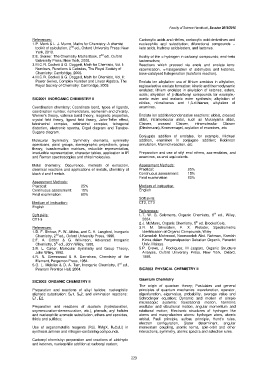Page 232 - handbook 20152016
P. 232
Faculty of Science Handbook, Session 2015/2016
References: Carboxylic acids and nitriles, carboxylic acid derivatives and
1. P. Monk & L. J. Munro, Maths for Chemistry: A chemist nucleophilic acyl substitution; difunctional compounds –
nd
toolkit of calculation, 2 ed., Oxford University Press: New keto acids, hydroxy acids/esters, and lactones.
York, 2010.
nd
2. E. Steiner. The Chemistry Maths Book, 2 ed., Oxford Acidity of the -hydrogen in carbonyl compounds; enol-keto
University Press: New York, 2008. tautomerism;
3. M.C.R. Cockett & G. Doggett, Math for Chemists, Vol. I: Reactions which proceed via enols and enolate ions:
Numbers, Functions & Calculus, The Royal Society of racemization, -halogenation of aldehydes and ketones,
Chemistry: Cambridge, 2003. base-catalysed halogenation (haloform reaction).
4. M.C.R. Cockett & G. Doggett, Math for Chemists, Vol. II:
Power Series, Complex Number and Linear Algebra, The Enolate ion alkylation: use of lithium enolates in alkylation,
Royal Society of Chemistry: Cambridge, 2003. regioselective enolate formation: kinetic and thermodynamic
enolates; lithium enolates in alkylation of ketones, esters,
acids; alkylation of -dicarbonyl compounds for example,-
SIC2001 INORGANIC CHEMISTRY II acetic ester and malonic ester synthesis; alkylation of
nitriles, nitroalkanes and 1,3-dithianes; alkylation of
Coordination chemistry: Coordinate bond, types of ligands, enamines.
coordination number, nomenclature, isomerism and chirality,
Werner's theory, valence bond theory, magnetic properties, Enolate ion addition/condensation reactions: aldols, crossed
crystal field theory, ligand field theory, Jahn-Teller effect, aldol, intramolecular aldol, such as Mukaiyama aldol,
tetrahedral complex, octahedral complex, tetragonal Claisen, crossed Claisen, intramolecular Claisen
distortion, electronic spectra, Orgel diagram and Tanabe- (Dieckmann), Knoevenagel, acylation of enamines, etc.
Sugano diagram.
Conjugate addition of enolates, for example, Michael
Molecular Symmetry: Symmetry elements, symmetry addition, enamines in conjugate addition; Robinson
operations, point groups, stereographic projections, group annulation, Mannich reaction, etc.
theory, transformation matrices, reducible representation,
irreducible representation, character tables, application in IR Preparation and use of silyl enol ethers, aza-enolates, and
and Raman spectroscopies and chiral molecules. enamines, as enol equivalents.
Metal chemistry: Occurrence, methods of extraction, Assessment Methods:
chemical reactions and applications of metals, chemistry of Practical: 25%
block d and f metals Continuous assessment: 15%
Final examination: 60%
Assessment Methods:
Practical: 25% Medium of instruction:
Continuous assessment: 15% English
Final examination: 60%
Soft skills:
Medium of instruction: CT2, CT3
English
References:
th
Soft skills: 1. T. W. G. Solomons, Organic Chemistry, 8 ed., Wiley,
CT1-3 2004.
th
2. J. McMurry, Organic Chemistry, 5 ed. Brooks/Cole.
References: 3. R. M. Silverstein, F. X. Webster, Spectrometric
1. D. F. Shriver, P. W. Atkins, and C. H. Langford, Inorganic Identification of Organic Compounds, Wiley
nd
Chemistry, 2 ed., Oxford University Press, 1996. 4. Kamaliah Mahmood, Noorsaadah Abd. Rahman, Kaedah
2. F. A. Cotton & G. Wilkinson, Advanced Inorganic Kimia dalam Pengenalpastian Sebatian Organik, Penerbit
th
Chemistry, 5 ed., John Wiley, 1988. Univ. Malaya.
3. R. L. Carter, Molecular Symmetry and Group Theory, 5. P. Crews, J. Rodriguez, M Jaspars, Organic Structure
John Wiley, 1998. Analysis, Oxford University Press, New York, Oxford,
4. N. N. Greenwood & A. Earnshaw, Chemistry of the 1998.
Element, Pergamon Press, 1984.
rd
5. G. L. Meisller & D. A. Tarr, Inorganic Chemistry, 3 ed.,
Pearson Prentice Hall, 2004. SIC2003 PHYSICAL CHEMISTRY II
Quantum Chemistry
SIC2002 ORGANIC CHEMISTRY II
The origin of quantum theory; Postulates and general
Preparation and reactions of alkyl halides: nucleophilic principles of quantum mechanics: wavefunction, operator,
aliphatic substitution: S N1, S N2; and elimination reactions: eigenfunction, eigenvalue, probability, average value and
E1, E2. Schrodinger equation; Dynamic and motion of simple
microscopic systems: translational motion, harmonic
Preparation and reactions of alcohols (hydroboration, oscillator and vibrational motion, angular momentum and
oxymercuration-demercuration, etc.), phenols, aryl halides rotational motion; Electronic structures of hydrogen like
and nucleophilic aromatic substitution, ethers and epoxides, atoms and many-electron atoms: hydrogen atom, atomic
thiols and sulfides; orbital, Pauli principle, aufbau principle, Hund's rules,
electron configuration, Slater determinant, angular
Use of organometallic reagents (RLi, RMgX, R 2CuLi) in momentum coupling, atomic terms, spin-orbit and other
synthesis amines and nitrogen-containing compounds. interactions, symmetry, atomic spectra and selection rules.
Carbonyl chemistry: preparation and reactions of aldehyde
and ketones, nucleophilic addition at carbonyl carbon;
223

